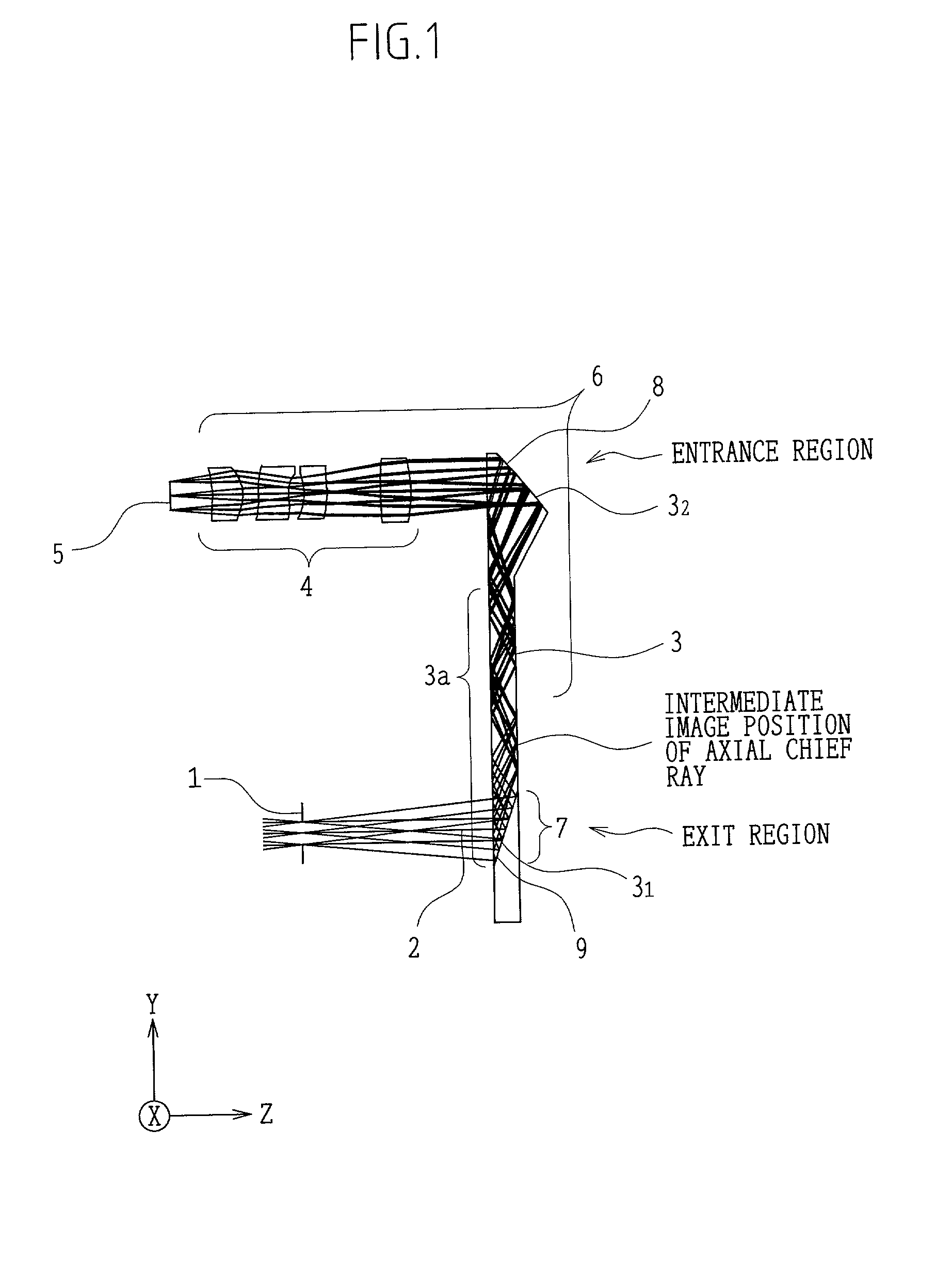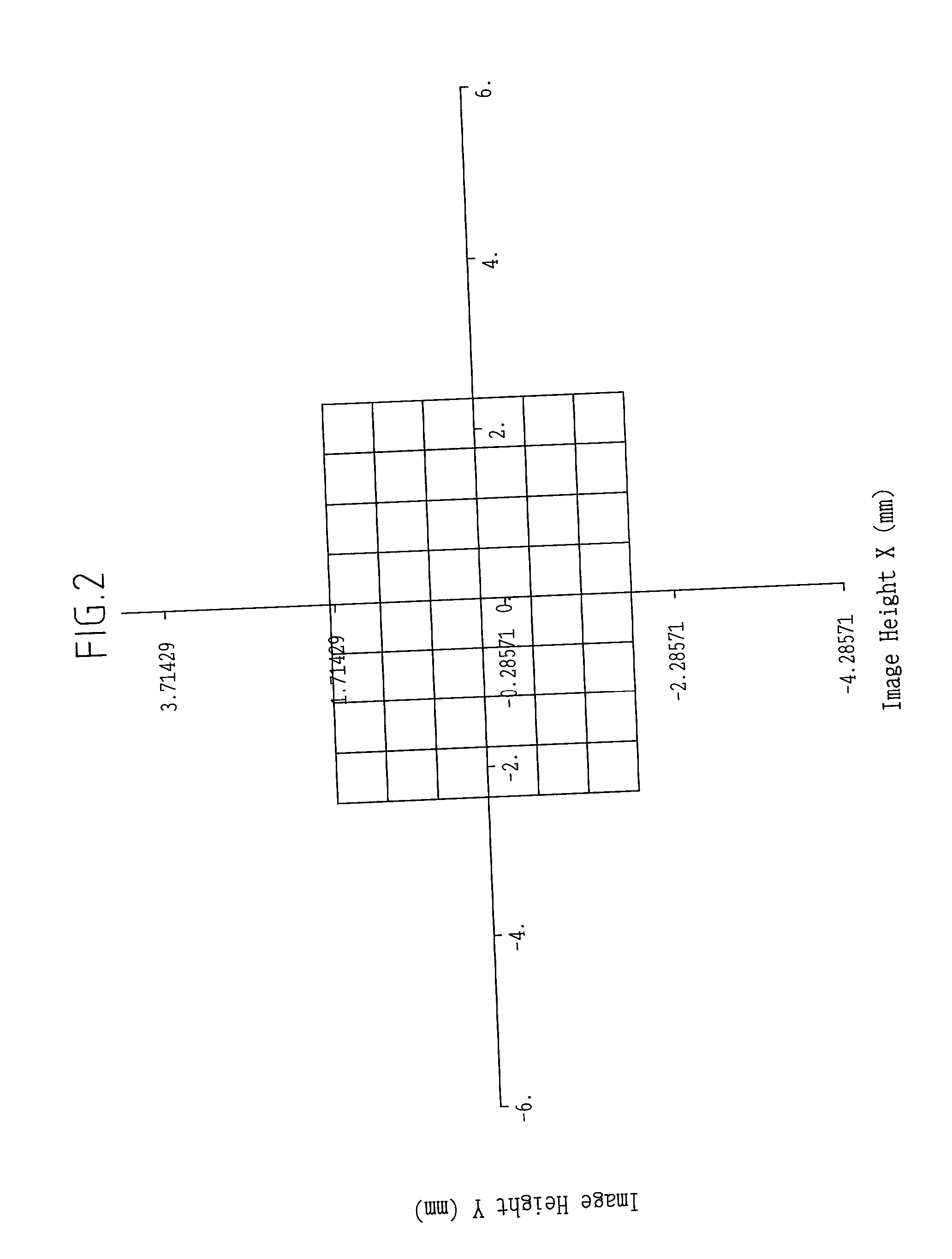Observation optical system
a technology of optical system and observation optical system, which is applied in the field of observation optical system, can solve the problems of bulkiness of the observation optical system, inability to lay out the relay optical system along the face of an observer, and difficulty in producing such a hologram with high-density interference fringes
- Summary
- Abstract
- Description
- Claims
- Application Information
AI Technical Summary
Problems solved by technology
Method used
Image
Examples
first embodiment
[0142] The observation optical system as shown in FIG. 1 includes a LCD 5 as the image display element which displays an image to be observed by an observer, a relay optical system 6 which relays image information formed on the LCD 5, and an eyepiece optical system 7 which introduces the image information relayed by the relay optical system 6 into the eye of the observer. Also, an exit pupil 1 is formed on the pupil surface so as to allow observation of the image displayed on the LCD 5.
[0143] The relay optical system has a plurality of lenses 4 and a first reflection-type HOE 8. The eyepiece optical system 7 has a second reflection-type HOE 9. The first reflection-type HOE 8 and the second reflection-type HOE 9 are formed on the predetermined base surfaces 3.sub.1, 3.sub.2, respectively, in the light-transmitting plate 3.
[0144] The light-transmitting plate 3 is filled with a transparent medium and is constructed and arranged to lead bundles of rays, which are reflected at least by ...
second embodiment
[0164] In the observation optical system according to the second embodiment shown in FIG. 6, the base surface 3.sub.2 of the light-transmitting plate 3 is shaped as a plane surface. The remaining basic configuration is substantially the same as the first embodiment.
[0165] The numerical data of the second embodiment is shown below. Also, FIG. 7, which presents the image distortion of the second embodiment, is drawn in the same manner as FIG. 2. FIGS. 8A-8L, FIGS. 9A-9L and FIGS. 10A-10L, which show lateral aberrations in the wavelength regions of R, G and B, respectively, are drawn in the same manner as FIGS. 3A-3L, FIGS. 4A-4L and FIGS. 5A-5L.
Numerical Data 2
[0166] pupil diameter .phi.:3 mm
[0167] horizontal full field angle:12.00.degree.
[0168] vertical full field angle:16.00.degree.
4 Surface Arrange. Radius of Surface Refractive Abbe's Hologram Number Curvature Separation Decentering Index Number Surface object .infin. -1000.00 surface 1 pupil 0.00 surface 2 .infin. 0.00 decentering...
third embodiment
[0170] In the optical system according to the third embodiment shown in FIG. 11, the plate surfaces of the light-transmitting plate 3 are shaped to have a curvature along the face of an observer. The configuration of the first embodiment or the second embodiment is applied to the remaining basic configuration.
[0171] Next, description is made of application examples where the observation optical system according to the present invention is used in a head-mount-type image display apparatus.
[0172] As shown in FIG. 12, a head-mount-type image display apparatus using the observation optical system according to the present invention is configured as a binocular image display apparatus having a pair of light-transmitting plates 3 for left and right eyes, a pair of cases 10 for left and right eyes, and a spectacle frame 11 which is held on the side heads of an observer. Each of the cases 10 holds therein an image display element 5 and a plurality of lenses as shown in FIG. 1 or FIG. 6. The ...
PUM
 Login to View More
Login to View More Abstract
Description
Claims
Application Information
 Login to View More
Login to View More - R&D
- Intellectual Property
- Life Sciences
- Materials
- Tech Scout
- Unparalleled Data Quality
- Higher Quality Content
- 60% Fewer Hallucinations
Browse by: Latest US Patents, China's latest patents, Technical Efficacy Thesaurus, Application Domain, Technology Topic, Popular Technical Reports.
© 2025 PatSnap. All rights reserved.Legal|Privacy policy|Modern Slavery Act Transparency Statement|Sitemap|About US| Contact US: help@patsnap.com



